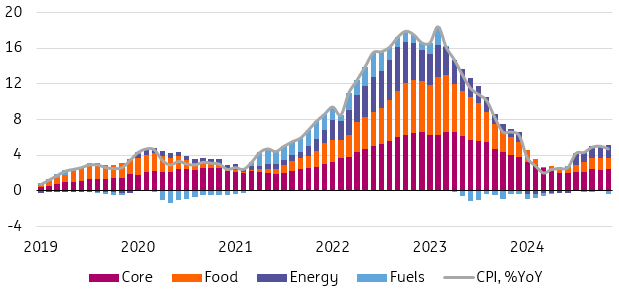Polish inflation shows limited room for easing in 2025
CPI inflation eased to 4.7% YoY in November, mainly on a statistical basis, while services and core inflation increased. The coming months should also bring a higher headline rate, peaking in March 2025. A decline later in 2025 should provide room for 75-100bp of rate cuts in 2025. The economy needs lower rates, but sticky core calls for moderate easing
Poland's StatOffice has revised up November's CPI reading from 4.6% to 4.7% year-on-year, according to the flash estimate. This is still a decrease from 5.0% YoY in October, but the overall tone from the data is not very encouraging.
The drop in headline CPI is mainly due to statistical effects, i.e., a high base on fuel, as last November we saw a recovery in fuel prices after the September-October promotions from the 2023 election period.
Other reasons for cautiousness include still sticky core inflation, which rose to around 4.3% YoY from 4.1% YoY in October. This was driven by robust growth in the price of services of 7.2% YoY in November, up from 6.7% YoY in October. Among other items, prices for telecommunications services (+1.9% month-on-month), water supply (+0.9% MoM), sewerage services (+0.7% MoM) and garbage collection (+0.6%MoM) rose compared to October. Tradeable goods prices growth slowed to 3.8% YoY from 4.3% YoY a month earlier.
Inflation down in November on high reference base in gasoline
CPI, %YoY, perc. points

The drop in headline inflation in November was largely due to statistical factors, and the broader inflationary landscape might still cause concern for consumers, prompting them to be cautious with their spending. Core inflation remains persistently high (over 4% YoY), and the increase in service prices exceeds 7% YoY. Administered prices (water, sewage) are rising because they were previously kept at an artificially low level.
Last week, the National Bank of Poland (NBP) President, Adam Glapiński, presented a scenario in which inflation rises significantly in the fourth quarter of 2025 due to the increase in energy prices after the electricity price cap (PLN 500/MWh) is lifted at the end of September next year. This, combined with the gradual release of artificially frozen regulated prices (natural gas, water, sewage), may weigh on consumer sentiment and drive inflation expectations.
We do not share the NBP governor’s opinion, and we expect that in mid-2025 the Energy Regulatory Office will lower the electricity tariffs and retail prices should remain broadly unchanged. Considering that wholesale prices in forward contracts for 2025 remain significantly below the current tariff for retail prices (PLN 623/MWh), the new tariff is unlikely to differ significantly from the current cap of PLN500/MWh. In this context, we still see room for interest rate cuts next year by 75-100bp – but in the context of recent statements by MPC members, the timing of the first cut is very uncertain, and the Council does not seem to have a clear vision of the optimal moment to start the monetary policy easing cycle.
This publication has been prepared by ING solely for information purposes irrespective of a particular user's means, financial situation or investment objectives. The information does not constitute investment recommendation, and nor is it investment, legal or tax advice or an offer or solicitation to purchase or sell any financial instrument. Read more
Download
Download snap